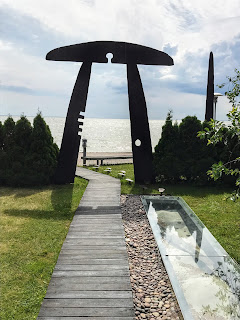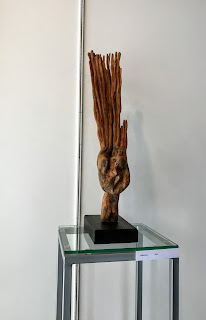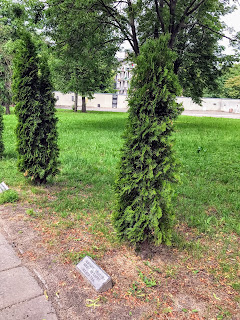Friday
Since we head back to the mainland today, we're up and out early, done with breakfast by 9:00, then off for a walk through town to the Amber Museum and Neringa History Museum. Amber is ubiquitous on the Curonian Spit. Much of it comes out of the lagoon and even more--in fact, the world's largest supply--is dug out of the sands on the southern half of the spit that is part of Kaliningrad, Russia. In shops and souvenir stands all over Nida, amber is hailed by its German name: bernstein, meaning "brown stone." Amber isn't actually stone at all; it's fossilized resin from ancient trees, so unlike rock, it is very light and quite flammable. As one vendor told me, burning is a good way to tell whether a piece of amber is authentic or a plastic knock-off--though, of course, with this test, by the time you know it's real, it's too late. . . . The museum is quirky and interesting; it's fun to learn more about amber through their eclectic collection of various colors, shapes, and sizes, including numerous pieces containing fossilized insects and plant materials. Given the commonality of bernstein as a Jewish name, I wonder if there is a significant history of Jews in the amber trade.
**********
Neringa is the name for the municipality that includes, essentially, the entire Lithuanian section of the Curonian Spit, with the four villages of Nida, Juodkrante, Preila, and Pervalka. The Neringa History Museum tells the story of this region: flora and fauna, human history, art and culture. The central gallery is filled with an array of contemporary wood sculpture. Traditional wood carving is much beloved in this heavily-forested nation. Over the course of our expedition, we've seen so many large folk art carvings, mostly either religious or nationalistic, sculpted in a realist style and displayed in parks and village squares. The exhibit here draws on that tradition, but the pieces are smaller, abstract and lyrical--a nice contemporary twist on an ancient national art.
After the museums, we walk back to our bed and breakfast, check out just before noon, enjoy a light lunch, then catch the 2:00 bus back to Smiltyne and the five-minute ferry across to Klaipeda. Rosa and I are both so grateful for our rest day on the Curonian Spit. Now we walk to our AirBnB apartment in Klaipeda's Old Town. We're greeted there by our host's husband who--small world--turns out to be an American who spent a few years working in Boise before he married the Lithuanian woman he met over the internet and moved here to be with her. He's friendly and eager to assist us. His first restaurant recommendation for dinner is a place called "Meat Lovers" but since that, obviously, will not work for me, we end up at a pan-Asian place for an early supper, then back to the apartment to welcome in our last Shabbat in Lithuania.
We have greeted the Shabbat bride in Vilna, Kovno, Keidan, and Jurbarkas. Now having arrived at land's end in Klaipeda, on the Curonian Lagoon, just across from the Baltic Sea, we kindle our tea candles, make kiddush over prosecco, and motzi with delicious hard white rolls. Next Shabbat, I'll be homebound, while Rosa makes her way to Tel Aviv, via Amsterdam. I have so much to celebrate: a remarkably successful journey, precious time with Rosa, the imminent arrival of Janet and Rachel and Jonah, who will meet us in Vilnius in just a day and a half. I am grateful for sacred labor and holy rest, for love and learning, family and friends, old and new. For darkness and light, for glimpses into my family and my people's past, even when tragic, and for the hope and promise of the future, even when uncertain. For the rivers, and for the Source of the rivers, that give us life, and sustain us, and enable us to mark this joyous day.
After the museums, we walk back to our bed and breakfast, check out just before noon, enjoy a light lunch, then catch the 2:00 bus back to Smiltyne and the five-minute ferry across to Klaipeda. Rosa and I are both so grateful for our rest day on the Curonian Spit. Now we walk to our AirBnB apartment in Klaipeda's Old Town. We're greeted there by our host's husband who--small world--turns out to be an American who spent a few years working in Boise before he married the Lithuanian woman he met over the internet and moved here to be with her. He's friendly and eager to assist us. His first restaurant recommendation for dinner is a place called "Meat Lovers" but since that, obviously, will not work for me, we end up at a pan-Asian place for an early supper, then back to the apartment to welcome in our last Shabbat in Lithuania.
We have greeted the Shabbat bride in Vilna, Kovno, Keidan, and Jurbarkas. Now having arrived at land's end in Klaipeda, on the Curonian Lagoon, just across from the Baltic Sea, we kindle our tea candles, make kiddush over prosecco, and motzi with delicious hard white rolls. Next Shabbat, I'll be homebound, while Rosa makes her way to Tel Aviv, via Amsterdam. I have so much to celebrate: a remarkably successful journey, precious time with Rosa, the imminent arrival of Janet and Rachel and Jonah, who will meet us in Vilnius in just a day and a half. I am grateful for sacred labor and holy rest, for love and learning, family and friends, old and new. For darkness and light, for glimpses into my family and my people's past, even when tragic, and for the hope and promise of the future, even when uncertain. For the rivers, and for the Source of the rivers, that give us life, and sustain us, and enable us to mark this joyous day.
Saturday
It's Shabbat morning, so we sleep late, then walk to what remains of the old Jewish cemetery on Sinagogu Gatve (Synagogue Street). Both the Nazis and the post-war Soviets ravaged the site leaving nothing save a few scattered markers. But after Lithuania achieved its independence in 1991, the Jewish community reclaimed this sacred ground. They embedded fragments of headstones into a memorial wall and added a monument to the Jews of Memel who were murdered in the Shoah. They also planted an avenue of junipers in honor of righteous gentiles who, at great personal risk, sheltered local Jews.
**********
For most of its history, Memel was a predominantly Prussian city. Its Jewish community was quite different from the Litvak centers to the east--more thoroughly western and profoundly influenced by secular Enlightenment ideas. As a border town, Memel often had two rabbis: one a German PhD, the other an old-fashioned rov in a long black kapote, with no secular education but deeply learned in talmudic matters. Here, East met West.
When Memel became a part of independent Lithuania between the two world wars, it was the country's second largest city, after the capital of Kaunas/Kovno (Vilnius was under Polish control during this period). It was a time of economic prosperity and as Memel grew, so did its Jewish community, from 4500 in 1928 to 6000 by 1939. Many were ardent Zionists.
Everything changed on March 20, 1939, when Hitler gave Lithuania an ultimatum: vacate Memel within twenty-four hours. As Samuel Greenhaus writes in his article in Memel's Yizkor book:
The same day, Lithuania bowed to the ultimatum. The entire city was covered with Hitler flags and Hitler's photograph. 40,000 Memel Germans went out into the streets and celebrated with wild enthusiasm. In one night, 7000 Jews escaped from the area.
Most of Memel's Jews fled into Lita, just across the border. They did not receive a warm reception from non-Jewish Lithuanians, who refused to recognize them as citizens, even though Memel/Klaipeda had been part of Lithuania for the past sixteen years. Most of them spoke no Lithuanian, Russian, or Polish. When the Red Army conquered Lithuania in 1940, they, too, disdained the Jewish refugees from Memel. But the Litvaks reached out to their Jewish brothers and sisters and did their best to support them, even as they struggled through their own political and economic difficulties. Of course when the Nazis invaded in June of 1941, the Memel Jewish refugees were slaughtered along with the rest of Lithuanian Jewry.
**********
The annexation of Memel turned out to be Hitler's final territorial acquisition before the Nazi invasion of Poland launched the Second World War. On the evening of May 22, 1939--just two days after issuing his ultimatum--Hitler personally traveled to Memel on a German battleship and delivered a speech from the balcony in the city's theater square, addressing the local citizens who, for the most part, welcomed him warmly.
Today, in the center of that square, stands a statue of Annchen von Tharau, the folk heroine of a seventeenth-century poem by local Prussian poet Simon Dach. She faces out into the plaza, with her back to the theater balcony where Hitler delivered his speech. As the story goes, Hitler had the statue removed before he spoke, because he could not stomach the notion that anyone--even a copper rendering of a fictional character--would turn away from him. Thankfully, Annchen was later restored to her proper place, and still looks away from that infamous balcony.
**********
Donald Trump is not Adolf Hitler. He's a cruel and ignorant bigot but not a genocidal dictator--at least not yet. Still, it's all too easy to imagine substituting Trump for Hitler in this story. It's just so Trump-like, that awful combination of deep insecurity and grotesque narcissism that renders an authoritarian leader utterly incapable of tolerating the mildest dissent, even from inanimate objects. Alas, while Annchen again stands proud, Hitler's victims are gone forever, lost to the world, with no hope of restoration.
Will we ever learn from this?
**********
Back in what remains of the old Memel cemetery, Rosa and I lay a Boise river rock and homemade hamsa bracelet by the Holocaust memorial. Then, just a hundred meters or so to our left, we notice a couple of men talking behind a modern brick building that turns out to be a small but active Orthodox synagogue. I greet the men in Hebrew and although their Shabbat morning service is over, they invite us to join them for kiddush and lunch. Inside, we find five or six community members gathered around a well-stocked table, including the very young Chabad rabbi. They welcome us warmly, ask about our time in Lithuania, make kiddush with abundant vodka, sing a couple of traditional zmiros, then serve us classic eastern European and Israeli salads. Since they don't speak English and we don't speak either Lithuanian or Yiddish, the entire conversation is in Hebrew. Mine is mediocre at best, but we understand one another, which feels good.
**********
As I sit with this small remnant of Jews in Klaipeda, it occurs to me that Chabad is the Jewish version of McDonald's, Starbucks, Ikea, or any other successful international franchise. They follow a strict cookie cutter approach, so they are pretty much the same wherever you go: Argentina, Nepal, Klaipeda, Boise. . . This strikes me as both their weakness and their strength. I find it a bit bland, short on local cultural spice that makes a community interesting in my eyes. Yet I realize that for many people, this formula works. It's reassuring, with an aura of authenticity, as if eighteenth century Ukrainian hasidism was the eternal, global Jewish norm. This strikes me as oddly out of place in Lithuania, the bastion of the Misnagdim, with their legacy of arch-rationalism and vehement opposition to the Hasidic movement. And it's even stranger here in Memel, a seat of the Prussian Haskallah/Enlightenment. But such is the landscape of Jewish life in 5777/2017.
And on this Shabbos afternoon, in the presence of a modest but enduring Jewish community, after so many cemeteries and ruins, I feel the appeal. Warmed by the whiskey--an integral piece of the Chabad formula--I'm filled with gratitude for my fellow flesh and blood Jews. Enough of the ghosts. No, the Lubavitchers are not the authentic heirs of Litvak culture. But Shabbos is Shabbos and kiddush is kiddush and I am grateful to this tiny congregation for taking us in. Rosa and I bentsch the Birkhat ha-Mazon quietly on our own, thank our hosts, and head out, wishing everyone Shabbat shalom.
**********
We enjoy a perfect Shabbat afternoon, walking all over Klaipeda on a gorgeous early summer's day, with blue skies and a gentle sea breeze. There's so much art, scattered around the streets and through the city parks. We stop for a happy hour glass of wine aboard an old schooner ship anchored in the harbor, eat pizza in an elegant courtyard, and, come nightfall, watch The Godfather on Netflix back at our AirBnB apartment.
It's one of those blessed days, with beauty at every turn. The highlight, for me, was the Clock Museum, a fascinating place that artfully documents the diverse methods humans have developed over the course of our history to mark and measure time. There are dozens of intricate mechanical clocks and watches, including some incredibly ornate Baroque and Rococo pieces, but I am most intrigued by earlier timekeeping methods: "clocks" that use water, sand, and even fire to delineate the passing moments.
Time is, as we construe it, a human artifice. We are, it seems, hard-wired to find ways to quantify the passing days, to divide them into hours and minutes and seconds. Perhaps our capacity to measure time offers the reassuring illusion that we can also control it, or even, sometimes, hold it at bay. I've spoken repeatedly of how Rosa and I are traveling metaphorically upstream but rivers don't give a damn about time and ultimately, neither water nor sand nor fire can really carry us back.
Ever forward flows the stream.
Tomorrow we return to where our journey began, Vilnius, where Janet, Rachel and Jonah will fly in to meet us.
Shavua tov. A good week.































1 comment:
Hello Dan, my name is Aurimas, one guy from Lithuania (Justas Pipiras) gave me your contacts. He mention that maybe you could have some good tips for my next trip. Because this summer I'm planning to kayak all the way missouri river. From the start in Montana (Missouri headwaters state park) to St. Louis. I'm planing to do it solo with kayak for two persons. I know that, this river have 15 dams and some waterfalls? Right? So maybe you have some tips for me? I would be really thankful:)peace:) Aurimas Valujavicius
Post a Comment